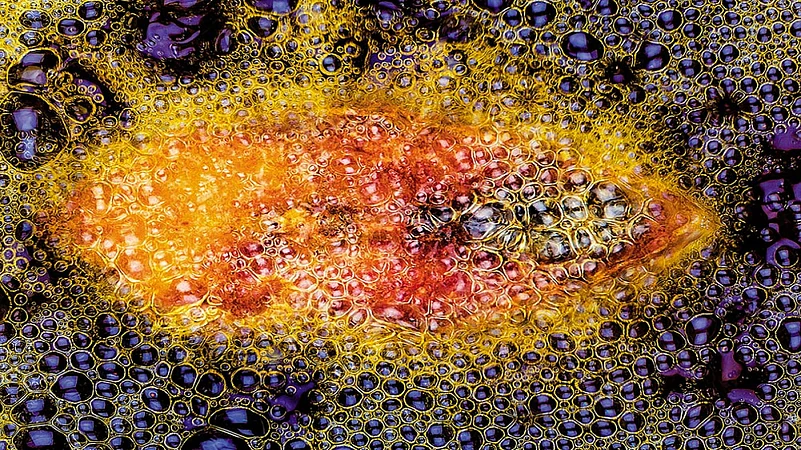Ilish machher tirish knata
Boal machher dari
Bhutto saheb bhikkha kore
Sheikh Mujib-er bari.
Roughly translated, the rhyme from 1971 means “The hilsa has 30 bones, the wallago catfish has a beard; Mr. Bhutto begs, in the backyard of Sheikh Mujib”. It taunts the then Pakistan prime minister Zulfikar Ali Bhutto, and spread like wildfire across East Pakistan (now Bangladesh), finding place in slogans, literature and graffiti, as Bangabandhu Sheikh Mujibur Rahman declared war against West Pakistan, seeking to liberate his homeland.
Fifty years later, the rhyme has faded into nostalgia. It can’t be said for sure if the founder of Bangladesh enjoys the same popularity now as in 1971. But the popularity of the flavourful and fatty fish with thousands of sharp pin-bones has remained unscathed, not only in Bangladesh, but also in its Indian ethno-cultural counterpart, West Bengal, which together made up undivided Bengal before 1947.
Cut to Calcutta, September 2021. “Hasina’s hilsa, straight from Padma,” shouted a fish vendor at the top of his voice at Baghajatin market in south Calcutta, his face flush from the light reflected by the silvery scales of the large fishes heaped in front of him. He shouted once every few minutes, announcing the new arrival in the market, as the faces in the crowd in front of him kept changing, without ever appearing to thin.
Every monsoon for the past six years, Mujib’s daughter, the present Bangladesh premier Sheikh Hasina—in a goodwill gesture that has earned the moniker of ‘hilsa diplomacy’ in West Bengal’s vernacular media—allows the export of hilsa from the rivers Padma and Meghna to India, with West Bengal being the biggest recipient. Long queues of buyers greet the crates of silvery delight from Bangladesh not only in markets of Calcutta but also in the suburban towns. Hasina makes West Bengal smile.
One can blame it on pollution and other human interventions that have disturbed the quality and flow of water in the Ganges, for Bangladesh getting the chance to woo India with the migratory fish that swims hundreds of nautical miles from the Arabian Sea to spawn in the freshwaters of the Ganges delta. But there is also a story of human migration behind West Bengal’s craze over Padma’s silvery crop.

Fishermen cast the net in the Hooghly; Hilsa getting cut and weighed to order at a Calcutta market
Journalist Avijit Ghosal is one of the many Hilsa aficionados whom Hasina’s gesture pleases. This September, no sooner had he learned of truckloads of Padmar ilish having crossed the Indo-Bangladesh border for Calcutta, than he ordered his fish vendor to get one for him at the earliest. He got more—two on two different days—both about 1.5 kg in weight. At home, they were cooked in two styles—one with salt, turmeric and black cumin, the other, called bhapa—steamed in mustard oil with mustard paste, green chilli and salt. During the cooking, the mouthwatering aroma acted as an appetiser, he said.
Now in his early 50s, Ghosal grew up hearing of the glory of the Padma hilsa from his parents. His father, Nirendranath, born and brought up in Barisal of present-day Bangladesh, spent some time in Barisal jail for participating in the Quit India movement. He was still in his 20s when he relocated to Calcutta ahead of the Partition. Ghosal grew up hearing his parents reminisce about missing the Padma hilsa, its size, abundance and delicacy.
“It was soft and tasty!” says Ghosal about his latest experience of savouring the fish. “But to tell the truth, even after tasting them so many times, I can’t be sure if the Padma hilsa tastes better than the Ganga (Hooghly) one. The Padma hilsa is usually bigger in size, but I think West Bengal’s longing for the Padma hilsa has more to do with nostalgia for a land our ancestors left to make this part of Bengal their home.”
There are millions of people in West Bengal whose ancestors crossed over from the east since the late 19th century, in search of better prospects around Calcutta, which was the biggest city of undivided Bengal. Migration continued after Independence, due to several other reasons, including persecution of religious minorities.
For ages, Bengalis in both sides of the Ganges Delta have enjoyed the reputation of being a fish-loving race. Machhey-Bhatey Bangali, roughly meaning ‘fish and rice for a Bengali’, is a common descriptor Bengalis use for themselves. They consume dozens of types of fish and have hundreds of recipes. But ilish is special—it’s Machher Rani or the queen of fishes. In monsoon, Ilish Utsob, or hilsa festival, is commonplace on both sides of the border.
To purists, ilish has the simplest of recipes—fewer spices the better. But it’s also served roasted, grilled, steamed in banana leaf and fried, with the mustard oil used for frying in the latter case also supplanting the curry.
It is not that only Bangals, or people originating in eastern Bengal, alone crave for the Padma hilsa. But the intensity of sentiments of Bangals over the fish can be guessed from the fact that Calcutta’s East Bengal Sporting Club—founded by east Bengal migrants in 1920 that has grown to become one of India’s biggest football clubs—has the hilsa as their symbol. Their supporters feast on it. Hilsa price shoots up in West Bengal’s markets every time East Bengal wins a derby against arch rivals Mohun Bagan, founded in 1889 by sons of the soil—referred to as Ghoti—for whom, prawn is the symbol.
An anadromous fish—born in freshwater, that spends most of its life in the sea but migrates to freshwater to spawn—the hilsa swims with the current created by the southwest monsoons. From the Bay of Bengal, they enter the major freshwater rivers—Ganga (Bhagirathi-Hooghly) and Rupnarayan in West Bengal, Padma and Meghna in Bangladesh, and Irawaddy in Myanmar—swim against the tide, moving upstream much like the salmon. The hilsa caught in river freshwater are considered much tastier than those caught in the sea.

Arrival of a hilsa consignment from Bangladesh at a Calcutta fish market is met with eager anticipation
The Ganges Delta accounts for over 90 per cent of global hilsa catch, with Myanmar, Pakistan and Kuwait being other countries of production. Because Padma is wider and deeper than Ganga, and the bigger share of the Bengal delta going to Bangladesh, it always drew more hilsa than Ganga. But in recent decades, Bangladesh has recorded a steady increase in annual production, while West Bengal has recorded a decrease, owing to a range of issues.
Hilsa is becoming scarcer in West Bengal, resulting in forbidding prices—those weighing around 1 kg cost more than Rs 1,500. The bigger the costlier. Over the past few years, as soon as trucks from Bangladesh start entering West Bengal, the state’s print, electronic and digital media start offering regular updates on price and markets where it’s available, with headlines frequently using the phrase “Hasina’s gift reaches Calcutta”.
But why would the export of hilsa to India be considered Bangladesh’s “gift”, especially when it earns the exporter significant revenue? That’s because West Bengal no longer has the abundance of hilsa to cater to the state’s demands.
“Hilsa is a hugely important economic and nutritional item in Bangladesh. Therefore, when concerns about the condition of hilsa stock and its long-term sustainability emerged, they became national concerns. The Bangladesh government approached the matter with dead seriousness,” wrote researcher Santanu Chacraverti, in a report titled ‘Hilsa Conservation in West Bengal: A Brief Study’, published in February this year. In contrast, he wrote, West Bengal’s measures were “feeble” and “half-hearted” at best.

While elaborating how West Bengal’s share of hilsa was dwindling, the report showed that in the average global share of the hilsa catch during 1984-2013, Bangladesh’s share stood at 74.5 per cent, while India’s was 18.3 per cent. But when the average share for 2010-2015 is considered, Bangladesh’s share stands at 86.7 per cent, while India’s share was only 8 per cent. West Bengal accounts for two-thirds of India’s hilsa catch. It was 13,510 tonnes of a total 20,180 tonnes in 2018.
For the declining hilsa catch in the Bhagirathi-Hooghly river system, environmentalists and researchers have mostly blamed disturbed water flow due to impact of barrages and dams that led to siltation at the mouth of the delta, reducing the depth of water—along with high levels of pollution and increased water abstraction, mostly for irrigation and industrial purposes, fishing of juvenile fish, mechanised fishing and lack of mesh-size regulation.
“Hilsa has a sharp memory. It returns to spawn where it was born. In its 4-5 year life span, it makes 3-4 attempts to return to the same place to breed. So, if the cycle is disrupted, the water is no longer conducive to spawning, the river loses depth and baby hilsas are caught, the inflow of the fish will dwindle,” says Arnab Biswas, a Calcutta-based ophthalmologist who has been researching on the fish for the past eight years, working with a range of specialists—fishermen, pisciculture and fossil experts, ichthyologists and oceanographers.
He has travelled across the coastal belt of India, Bangladesh and Myanmar and found evidence of the one-time presence of the fish in most unlikely places, like Rajasthan in the northwest and Mizoram in the northeast of India.
While explaining West Bengal’s love for the Padma hilsa, Biswas said he did not think taste was a factor. “Taste is subjective. The enthusiasm over Padma hilsa is mainly due to two reasons. The first is nostalgia for those who arrived from east Bengal and exotica for those with roots in west Bengal. The second is the dwindling hilsa catch in West Bengal’s rivers,” he said.
According to him, hilsa needs 40-feet-deep water, but the Farakka Barrage in Malda has disrupted the flow of the Ganges. There’s also a lack of regular dredging. As a result, there are places where the river is only 10-feet deep.
He added there was a time not too long ago when hilsa could be found in Ganga at Allahabad, 900 km upstream from the rivermouth. Now, the catch has dwindled so much, it’s hard to find even at Diamond Harbour, 70 km upstream.
There are other early warnings of the impending scarcity of hilsa in West Bengal’s rivers. “What do you make of a hilsa weighing only 500 gm, carrying eggs?” Biswas asks, and proceeds to answer, “It means the species is feeling endangered, entering the reproductive stage early and getting smaller in size to cope with the changes.”
If that’s not alarming enough, there is the example of the fish nearly vanishing from the Indus Valley. Jhulelal, the folk deity also called Zinda Pir, rides a hilsa, called palla in Pakistan’s Sindh. An animal that enjoys the status of being a carrier of a god is good enough proof of its cultural significance in society. Now, they are rarely found in the Indus. Scientists have blamed reduced water flow and pollution in the river for the dwindling catch—just as in the Ganga.
If hilsas stop entering the Bhagirathi-Hooghly system, it would lead to human migration from West Bengal, as a large section of the population is economically dependent on the fish. “Fisherfolk from West Bengal’s southern districts are already migrating to the western coast for better prospects, as the dwindling catch of hilsa, their main cash churner, has severely affected their livelihoods,” said Debashis Shyamal, a leader of Dakshinbanga Matsajibi Forum, an organisation of fisherfolks active in the area.
In that case, the Padma hilsa will reign over West Bengal, perhaps also allowing Bangladesh to drive a harder bargain with India for a share of Teesta river water, which they are not getting now due to West Bengal’s objections.
(This appeared in the print edition as "Silver Fins, Golden Halo")
By Snigdhendu Bhattacharya in Calcutta


























